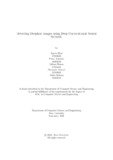| dc.contributor.advisor | Parvez, Mohammad Zavid | |
| dc.contributor.advisor | Karim, Dewan Ziaul | |
| dc.contributor.author | Dhar, Arpita | |
| dc.contributor.author | Acharjee, Prima | |
| dc.contributor.author | Biswas, Likhan | |
| dc.contributor.author | Ahmed, Shemonti | |
| dc.contributor.author | Sultana, Abida | |
| dc.date.accessioned | 2022-01-17T04:34:17Z | |
| dc.date.available | 2022-01-17T04:34:17Z | |
| dc.date.copyright | 2021 | |
| dc.date.issued | 2021-09 | |
| dc.identifier.other | ID 17101069 | |
| dc.identifier.other | ID 18301293 | |
| dc.identifier.other | ID 17101405 | |
| dc.identifier.other | ID 21341062 | |
| dc.identifier.other | ID 16201085 | |
| dc.identifier.uri | http://hdl.handle.net/10361/15933 | |
| dc.description | This thesis is submitted in partial fulfillment of the requirements for the degree of Bachelor of Science in Computer Science and Engineering, 2021. | en_US |
| dc.description | Cataloged from PDF version of thesis. | |
| dc.description | Includes bibliographical references (pages 36-40). | |
| dc.description.abstract | In recent years, advancement in the realm of machine learning has introduced a
feature known as Deepfake pictures, which allows users to substitute a genuine face
with a fake one that seems real. As a result, distinguishing between authentic and
fraudulent pictures has become di cult. There have been several cases in recent
years where Deepfake pictures have been used to defame famous leaders and even
regular people. Furthermore, cases have been documented in which Deepfake yet
realistic pictures were used to promote political discontent, blackmail, spread fake
news, and even carry out false terrorism attacks. The objective of our model is to
di erentiate between real and Deepfake images so that the above mentioned situations
can be avoided. This project represents a deep CNN model with 13000 images
divided in two segments: Training and Testing. The dataset was prepared using necessary
image augmentation techniques. A total of 2 categories are considered (real
image category and fake image category). For testing purpose we have used a total
number of 3000 images divided into two parts for real and fake class, each consisting
1500 images. 75% of the whole data was used as Testing data and remaining 25%
as Training data. The dataset was tested against a custom CNN model referred to
in the paper as the 18-layered CNN model and ve of the transfer learning models.
Our suggested model was successful in achieving 98.77% accuracy whereas the best
result out of the transfer learning model was achieved by InceptionV3 with 97.10%
testing accuracy. The custom CNN model shows promising results in the case of
detecting real and DeepFake images than all the other models used before. | en_US |
| dc.description.statementofresponsibility | Arpita Dhar | |
| dc.description.statementofresponsibility | Prima Acharjee | |
| dc.description.statementofresponsibility | Likhan Biswas | |
| dc.description.statementofresponsibility | Shemonti Ahmed | |
| dc.description.statementofresponsibility | Abida Sultana | |
| dc.format.extent | 40 pages | |
| dc.language.iso | en | en_US |
| dc.publisher | Brac University | en_US |
| dc.rights | Brac University theses are protected by copyright. They may be viewed from this source for any purpose, but reproduction or distribution in any format is prohibited without written permission. | |
| dc.subject | CNN | en_US |
| dc.subject | Deepfake | en_US |
| dc.subject | Deep learning | en_US |
| dc.subject | Image processing | en_US |
| dc.subject | Transfer learning | en_US |
| dc.subject.lcsh | Neural networks (Computer science) | |
| dc.subject.lcsh | Artificial intelligence | |
| dc.subject.lcsh | Image processing -- Digital techniques. | |
| dc.title | Detecting Deepfake images using deep convolutional neural network | en_US |
| dc.type | Thesis | en_US |
| dc.contributor.department | Department of Computer Science and Engineering, Brac University | |
| dc.description.degree | B. Computer Science | |

